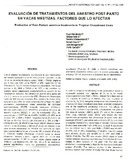Mostrar el registro sencillo del ítem
Evaluación de tratamientos del anestro post-parto en vacas mestizas factores que lo afectan
| dc.rights.license | http://creativecommons.org/licenses/by-nc-sa/3.0/ve/ | |
| dc.contributor.author | Hernández F., Hugo | |
| dc.contributor.author | Soto Belloso, Eleazar | |
| dc.contributor.author | Villamediana, Patricia | |
| dc.contributor.author | Cruz A., Robert | |
| dc.contributor.author | Aranguren Méndez, José Atilio | |
| dc.contributor.author | Castejón, Osiris | |
| dc.date.accessioned | 2009-02-26T15:42:37Z | |
| dc.date.available | 2009-02-26T15:42:37Z | |
| dc.date.issued | 2009-02-26T15:42:37Z | |
| dc.identifier.issn | 0798-2259 | |
| dc.identifier.uri | http://www.saber.ula.ve/handle/123456789/26913 | |
| dc.description.abstract | Con el objetivo de comparar la eficiencia de dos tratamientos del anestro post-parto a los 90 días (control, inyección i.m. de 10 cc de solución fisiológica estéril; SMB + PMSG, implante por 9 días con 1000 u.l de PMSG; y VFL, inyección i.m. de Vitaminas A. D3 y E, fósforo inorgánico y levamisol), 113 vacas (control = 46, SMB + PMSG = 32, VFL = 35) mestizas en anestro fueron adjudicadas aleatoriamente a algunos de los tratamientos indicados. Se midieron los efectos de la época del año (E), sistema de producción (SP), Producción Acumulada hasta los 100 días de lactancia (PA), número de partos (NP), sexo de la cría (SC), condición corporal (CC) y Raza (R), sobre parámetros reproductivos como porcentaje de ciclicidad post-tratamiento (PCPT), intervalo parto-celo (IPARCE), intervalo parto-concepción (IPARCO), porcentaje de vacas en anestro orgánico (PVAO) y tasa de concepción (TC). Se encontró que el PCPT fue de 43.48%, 34.29% y 81.25% en el Control, VFL y SMB + PMSG, respectivamente (P<0.001). La TC fue de 45.45%, 50.0% y 28.13% para el C, VFL y SMB + PMSG (P>0.05). El IPARCE fue menor (89.21 días) en vacas tratadas entre diciembre y febrero (P<0.05) en relación a las otras épocas estudiadas. El IPARCE fue acortado en cinco días aproximadamente por efecto del SP mejorado (P<0.05). El IPARCO mostró diferencias (P<0.05) entre la época diciembre – febrero y junio – agosto (84.2 vs 111.78 días respectivamente). El SP no mostró efecto alguno sobre el IPARCO. Los factores PA, NP, SC, CC y R, no mostraron efectos significativos sobre los parámetros reproductivos estudiados (P>0.05). El SMB + PMSG constituye una alternativa terapéutica exitosa para el anestro post-parto. Sin embargo, SP y E afectaron la efectividad de los tratamientos. | es_VE |
| dc.rights | info:eu-repo/semantics/openAccess | |
| dc.subject | Vacas | es_VE |
| dc.subject | Anestro | es_VE |
| dc.subject | Post-parto | es_VE |
| dc.subject | Smb | es_VE |
| dc.subject | Pmsg | es_VE |
| dc.title | Evaluación de tratamientos del anestro post-parto en vacas mestizas factores que lo afectan | es_VE |
| dc.title.alternative | Evaluation of Post-Partum anestrus treatments in Tropical Crossbred cows | es_VE |
| dc.type | info:eu-repo/semantics/article | |
| dc.description.abstract1 | In order to compare the efficiency of two post-partum anestrus treatments (control, i.m. injection of 10 cc of an sterile physiological solution; SMB + PMSG, implant for 9 days and an i.m. injection of 1.000 i.u. of PMSG; VFL, i.m. injections of vitamins A, D3, & E, inorganic phosphorus and levamisol) 113 anestrus (90 days) crossbred cows were randomly assigned to one of the treatments previously indicated. The effects of season (S), production system (PS), accumulative milk yield at 100 days of lactation (AMY), parity (P), sex of the newborn (SN), body condition score (BCS) and breed (B) over reproductive parameters like percentage of cyclic cows after treatment (PCCAT), parturition estrus interval (PEI), parturition conception interval (PCI), percentage of organic anestrus cows (POAC) and conception rate (CR) were studied. It was found that the PCCAT for C, VFL and SMB + PMSG was 43.48%, 34.29% and 81.25% respectively (P<0.001). The CR values were 45.45%, 50.0% and 28.13 for C, VFL and SMB + PMSG (P>0.05). The PEI was shorter (89.21 days) in cows treated between december and february (P<0.05) than in those treated in other seasons of the year. The PEI was also shortened in approximately 5 days by the improved production system (P<0.05). The animals treated in the december-february season had shorter (P<0.05) PCI than those treated from june to august (54.2 days v 111.78 days respectively), with no other differences being detected among seasons. PCI was not affected by the PS, AMY, P, SN, BCS and B had no significant effects over the studied reproductive parameters (P>0.05). It is concluded that SMB + PMSG can be a successful treatment for post-partum anestrus. However, SP and E affected the efficiency of the treatments used. | es_VE |
| dc.description.colacion | 47 - 53 | es_VE |
| dc.description.email | patriciavillamediana@cantv.net | es_VE |
| dc.description.frecuencia | Cuatrimestral | |
| dc.identifier.depositolegal | 199102ZU46 | |
| dc.subject.institutoinvestigacion | Universidad del Zulia (LUZ) | |
| dc.subject.institutoinvestigacion | Universidad de Los Andes (ULA) | |
| dc.subject.keywords | Cows | es_VE |
| dc.subject.keywords | Anestrus | es_VE |
| dc.subject.keywords | Post-partum | es_VE |
| dc.subject.keywords | Smb | es_VE |
| dc.subject.keywords | Pmsg | es_VE |
| dc.subject.publicacionelectronica | Revista Científica | |
| dc.subject.tipo | Revistas | es_VE |
| dc.type.media | Texto | es_VE |
Ficheros en el ítem
Este ítem aparece en la(s) siguiente(s) colección(ones)
-
Revista Científica - 1995 - Vol. V - No. 001
enero - abril



